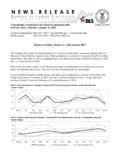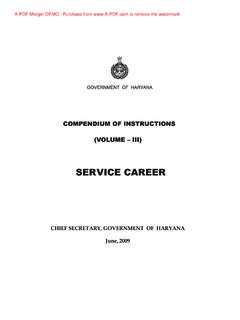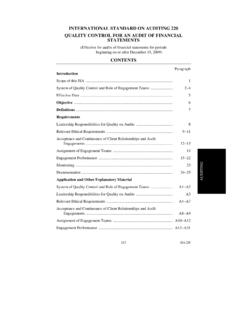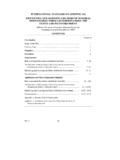Transcription of The Recession of 2007–2009
1 BLS SPOTLIGHT ON STATISTICS THE Recession OF 2007 2009 BUREAU OF LABOR STATISTICS 1 The Recession of 2007 2009 February 2012 A general slowdown in economic activity, a downturn in the business cycle, a reduction in the amount of goods and services produced and sold these are all characteristics of a Recession . According to the National Bureau of Economic Research (the official arbiter of recessions ), there were 10 recessions between 1948 and 2011. The most recent Recession began in december 2007 and ended in June 2009 , though many of the statistics that describe the economy have yet to return to their pre- Recession values.
2 In this Spotlight, we present BLS data that compare the recent Recession to previous recessions . BLS SPOTLIGHT ON STATISTICS THE Recession OF 2007 2009 BUREAU OF LABOR STATISTICS 2 Unemployment One of the most widely recognized indicators of a Recession is higher unemployment rates. In december 2007, the national unemployment rate was percent, and it had been at or below that rate for the previous 30 months. At the end of the Recession , in June 2009 , it was percent. In the months after the Recession , the unemployment rate peaked at percent (in October 2009 ).
3 Before this, the most recent months with unemployment rates over percent were September 1982 through June 1983, during which time the unemployment rate peaked at percent. Compared with previous recessions , the higher proportion of long-term unemployed (those unemployed for 27 weeks or longer) in the recent Recession and its post- Recession period is notable. NOTE: People are classified as unemployed if they do not have a job, have actively looked for work in the prior 4 weeks, and are currently available for work.
4 The unemployment rate is the number of unemployed persons as a percent of the labor force. (The labor force is the total number of employed and unemployed persons.) The long-term unemployment rate is the number of persons unemployed for 27 weeks or longer as a percent of the labor force. To learn more, see How the Government Measures Unemployment, Source: Current Population Survey BLS SPOTLIGHT ON STATISTICS THE Recession OF 2007 2009 BUREAU OF LABOR STATISTICS 3 Unemployment Demographics Unemployment rates of Blacks or African Americans and Hispanics or Latinos historically have been higher than the rate for the months during and after the recent Recession , unemployment rates for Blacks or African Americans and Hispanics or Latinos remained below the peaks they reached in 1982 and 1983, while the unemployment rate of Whites was very comparable to that of 1983.
5 Source: Current Population Survey BLS SPOTLIGHT ON STATISTICS THE Recession OF 2007 2009 BUREAU OF LABOR STATISTICS 4 For many years, men's unemployment rates were generally lower than women's both during and between recessions . However, since the early 1980s, men's unemployment rates have been higher than women's during or immediately after recessions , and the rates for men and women have been quite similar in other periods. Higher unemployment among men was especially notable during and immediately after the recent Recession .
6 Source: Current Population Survey BLS SPOTLIGHT ON STATISTICS THE Recession OF 2007 2009 BUREAU OF LABOR STATISTICS 5 Unemployment by State Unemployment rates vary from one place to another. In the months after the end of the recent Recession , North Dakota, Nebraska, and South Dakota had the lowest monthly unemployment rates ( percent or lower) among the 50 states. Nevada, California, and Michigan had some of the highest jobless rates (above percent). (This is an interactive chart on the BLS Spotlight HTML page.)
7 Source: Local Area Unemployment Statistics BLS SPOTLIGHT ON STATISTICS THE Recession OF 2007 2009 BUREAU OF LABOR STATISTICS 6 Unemployment Rates Around the World Compared with the unemployment rates of other industrialized countries, the unemployment rate was higher than a few and lower than most other countries before the start of the most recent Recession . By the end of the recent Recession , the unemployment rate was higher than most other industrialized countries, and it remained so in the months following the Recession .
8 (This is an interactive chart on the BLS Spotlight HTML page.) Source: International Labor Comparisons BLS SPOTLIGHT ON STATISTICS THE Recession OF 2007 2009 BUREAU OF LABOR STATISTICS 7 Employment Fell More Rapidly Than During Prior recessions The employment decline experienced during the december 2007 June 2009 Recession was greater than that of any Recession of recent decades. Forty-seven months after the start of the Recession that began in november 1973, for example, employment was more than 7 percent higher than it had been when the Recession started.
9 In contrast, 47 months after the start of the most recent Recession ( november 2011), employment was still over 4 percent lower than when the Recession began. NOTE: In this chart, employment levels for recent recessions are set equal to 100 at the start of each Recession . The solid boxes on the chart indicate the beginning of recessions . The empty box markers on each line indicate ends of recessions . On the line for the Recession that began in January 1980, a second solid box indicates the start of another Recession that began in July 1981. BLS SPOTLIGHT ON STATISTICS THE Recession OF 2007 2009 BUREAU OF LABOR STATISTICS 8 Source: Current Employment Statistics BLS SPOTLIGHT ON STATISTICS THE Recession OF 2007 2009 BUREAU OF LABOR STATISTICS 9 Employment of Young Adults Employment of young adults declined as it did in all other groups during the recent Recession .
10 Employment of young men generally increased during much of 2006. After a dip in late 2006, employment of young men trended upward and then remained fairly stable until late fall of 2008, well into the recent Recession . After a peak of about 88 percent in fall 2007, young men's employment declined from late fall 2008 until June 2009 , when it was just over 82 percent. As a share of population, employment of young women tended to be about 8 to 9 percentage points below that of young men. After reaching a peak of over 79 percent in late 2007, employment of young women remained fairly stable through about december 2008, and then, similar to that of men, it declined until it was about 73 percent in June 2009 .
















